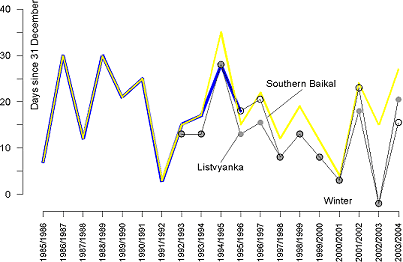
Ice on Lake Baikal
Ice on Lake Baïkal are not sea ice but their spead can also be measured by altimetry.
The date when a lake is frozen, or freed by ice are major climate indicators. Lake Baikal is the deepest and biggest lake in the world (it contains 20 % of fresh water on Earth excluding glaciers), with specific fauna and flora. Ice cover influences such physical water parameters as its transparency, temperature, turbulence, water stratification, currents, etc., as well as primary production and spring diatoms blooms. Moreover, its iced surface is used as a road in winter, with thus an economic impact of such information.
The lake ice cover can be studied using simultaneously the power received by the radar altimeters after reflection on the surface (backscatter coefficient) in Ku band and the brightness temperature from the bi-frequency radiometers onboard Topex/Poseidon, Jason-1, Envisat and GFO, combined with passive microwave measurements (like those of SSM/I). Comparing these two kinds of information, it is possible to determine the type of surface - ice or water.
The data obtained on the basis this information (i.e. dates when the lake is completely frozen, when the ice breaks up, and fast-ice duration) match well the in situ observations, unfortunately scarcer and scarcer (and more difficult to access).
More information :
- Image of the Month, May 2006 : Ice on Lake Baikal.
- Earth Observatory (Nasa) website, image from Modis instrument: Ice Melting on Lake Baikal (May 2012)
- Kouraev, A. et al. 2007. Observations of Lake Baikal Ice from Satellite Altimetry and Radiometry. Remote Sensing of Environment, 10 (1016), 11-010. DOI: 10.1016/j.rse.2006.11.010





